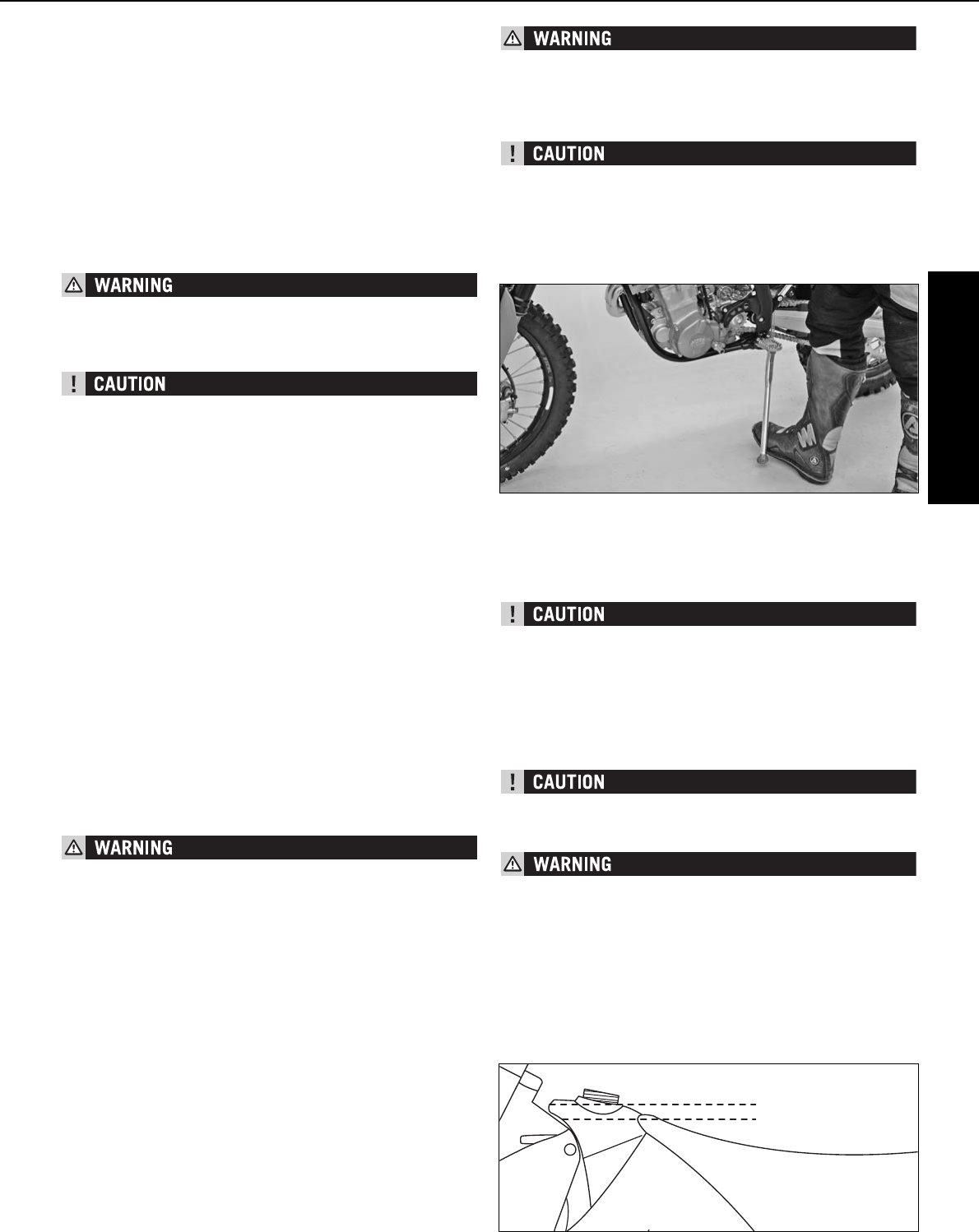
DRIVING INSTRUCTIONS
»
ENGLISH
19
35 mm
NOTE: dedicated to nothing but offroad racing, these models make
no compromises in their design. As such, they do not include any
radiator fan, and the size of the radiator is dimensioned for opti-
mum ergonomics.
In normal racing, the cooling system is sufficient.
If you use your motorbike in other conditions, please note that:
the E-starter allows you to start every model accept SX-F again at
any time. Therefore, turn off the engine if you intend to run your
motorcycle in idle or at a standstill for longer periods of time (more
than 2 minutes).
Avoid letting the clutch slip frequently and for extended periods.
This would cause the engine oil to heat up, thereby heating up the
cooling system. You should drive at low speeds (4-stroke style -
letting the engine pull you) and not at high speeds not by letting
the clutch slip (2-stroke style).
– After falling with the motorcycle, check all functions thoroughly
before starting up operations again.
– A twisted handlebar must always be replaced. Do not adjust
the handlebar, it will lose stability.
– High rpm rates when the engine is cold have an adverse effect
on the life of your engine. We recommend you run the engine
in a moderate rpm range for a few miles giving it a chance to
warm up. After that no further precautions in this respect need
to be taken. The engine has reached its operating temperature
as soon as the radiators become warm.
– Never have the throttle wide open when changing down to a
lower gear. The engine will over-rev, damaging the valves. In
addition, the rear wheel locks so that the motorcycle can eas-
ily get out of control.
– If any abnormal vibrations occur while driving, check that the
engine fastening bolts are tight.
– In the event that, while riding on your motorcycle, you notice
any unusual operation-related noise, stop immediately, turn the
engine off, and contact an authorized KTM dealer.
Braking
Close throttle and apply the hand and foot brakes at the same time.
When driving on sandy, wet or slippery ground use mainly the rear
wheel brake. Always brake with feeling, blocking wheels can cause
you to skid or fall. Always finish braking before you enter a curve.
Also change down to lower gears depending on your speed.
When driving down hill, use the braking effect of the engine.
Change down one or two gears but do not overspeed the engine.
In this way, you will not need to brake so much and the brakes will
not overheat.
– In case of rain, after washing the motorcycle, after rides through
water and in case of rides on wet off-road tracks, humid or dirty
brake discs can delay the braking effect. The brakes must be
pulled until they are dry or clean.
–
Rides on salt-strewed or dirty roads can also delay the braking effect.
The brakes must be pulled until they are clean.
– Dirty brake discs cause increased tear of brake pads and brake
discs.
– When you brake, the brake discs, brake pads, brake caliper and
brake fluid heat up. The hotter these parts get, the weaker the
breaking effect. In extreme cases, the entire braking system
can fail.
– If the resistance in the hand brake lever or foot brake pedal
feels “spongy” (too much play), this is an indication that some-
thing is wrong with the brake system. Don’t ride your motorcy-
cle anymore without first having the brake system looked over
by a KTM dealer.
Stopping and parking
Apply the brakes fully and put the engine into neutral. To turn off
the engine, push the short-circuit button or the emergency-OFF
button with the engine at idling speed until the engine stops. Turn
the fuel tap to the OFF position, park on an area where the ground
is firm, and lock the motorcycle.
Motorcycle engines produce a great amount of heat while running.
The engine, exhaust pipe, muffler, brake rotors, and shock absorbers
can become very hot. Do not touch any of these parts after operating
the motorcycle, and take care to park it where pedestrians are not
likely to touch it and get burned.
– Never use the hand decompression lever to turn off the engine.
Use the short-circuit button or the emergency-off button instead.
– Close the fuel tap when leaving your vehicle.Otherwise the car-
burettor can flood and fuel will enter the engine.
– Never park your motorcycle in places where there are fire haz-
ards due to dry grass or other easily flammable materials.
NOTE REGARDING THE SIDE STAND:
Use your foot to kick side stand forward up to the stop and lean
the motorcycle sideways. Make sure that the ground is solid and
that your motorcycle is standing securely. Just in case, you can
shift into first gear.
The side stand is designed to bear only the load of the motorcycle.
The side stand and/or the frame can be damaged and the motor-
cycle can fall over if you mount the motor-cycle, thus putting an
additional load on the side stand.
Fuel
The engine needs unleaded fuel with at least RON 95 (USA =
Premium PON 91).
Use leaded or unleaded premium grade gasoline (95 octanes). Never
use gasoline having less than 95 octanes because it may damage
the engine.
Gasoline is highly flammable and poisonous. Extreme caution should
be used when handling gasoline. Do not refuel the motorcycle near
open flames or burning cigarettes. Always switch off the engine before
refuelling. Be careful not to spill gasoline on the engine or exhaust
pipe while the engine is hot. Wipe up spills promptly. If gasoline is
swallowed or splashed in the eyes, seek a doctor’s advice immedi-
ately.
Fuel expands when its temperature rises. Therefore do not fill the
tank to the top (see fig.).


















